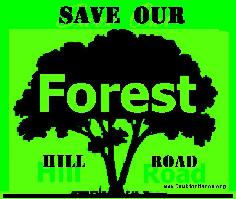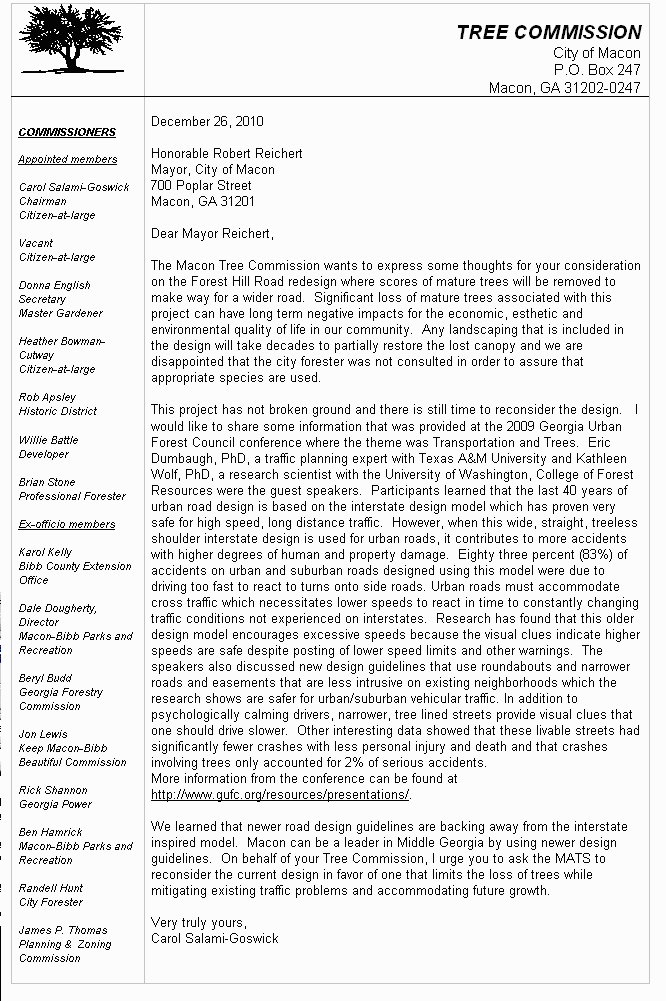
return to
Forest Hill Road
January 20, 2012.
Macon Tree Commission notifies Mayor Reichert that the Forest Hill
Rd landscaping plan doesn not conform to the local tree
ordinances.
click above for printable PDF format copy

printable copies of the
letter:
http://www.macon-bibb.com/FHR/Mayor-FHR-TreeComm2.doc
http://www.macon-bibb.com/FHR/Mayor-FHR-TreeComm.rtf
| Text version of the
letter: |
|||
| FHR |
|
FHR |
|
TREE
COMMISSION
City of Macon P.O. Box 247 Macon, GA 31202-0247 COMMISSIONERS Appointed members Carol Salami-Goswick Chairman Citizen-at-large Vacant Citizen-at-large Donna English Secretary Master Gardener Heather Bowman-Cutway Citizen-at-large Rob Apsley Historic District Willie Battle Developer Brian Stone Professional Forester Ex-officio members Karol Kelly Bibb County Extension Office Dale Dougherty, Director Macon-Bibb Parks and Recreation Beryl Budd Georgia Forestry Commission Jon Lewis Keep Macon-Bibb Beautiful Commission Rick Shannon Georgia Power Ben Hamrick Macon-Bibb Parks and Recreation Randell Hunt City Forester James P. Thomas Planning & Zoning Commission |
|||
| From: "Carol" <CSGoswick@cox.net> To: <Nadine.Simonds@macon.ga.us> Cc: "Rob Apsley" <raps4la@aol.com>, "randell hunt" <randell_hunt@yahoo.com>, "Holliday Dental" <teeth@mindspring.com> Subject: Forest Hill Road follow-up Date: Wed, 2 Mar 2011 09:52 Hi Nandine, Please share the attached letter with Mayor Reichert acknowledging the Tree Commission’s follow-up with Van Etheridge re: his letter on the Forest Hill Road project. Thanks for your help, Carol Salami-Goswick 478-746-2247, 478-714-3042c "Each generation takes the earth as trustees.” J. Sterling Morton |
|||
March 2, 2011 Van Etheridge, Program Manager Macon-Bibb County Road Improvement Program 111 Third Street, Suite 230 Macon, GA 31201-0502 Re: Forest Hill Road – Landscaping Plans Dear Mr. Etheridge: Thank you for taking time to show me the landscaping plans for the Forest Hill Road project. The Tree Commission did not receive a report from Peter Ranalet during his time as City Forester or his successors and I was pleased to hear that you have taken the City of Macon Tree Ordinance into consideration in developing the landscape plans. During our meeting you offered to provide the Commission with a copy of the plan and provide a comparison of the trees removed versus the replacement trees to be planted. The Commission appreciates and accepts your offer. To be consistent with the provisions of the ordinance, the comparison should include caliper removed and caliper restored. The Commission looks forward to receiving and reviewing your report with the current City Forester, Randall Hunt. Very truly yours, Carol Salami-Goswick, Immediate past chairman Cc: Mayor Robert Reichert Rob Apsley Randell Hunt Lindsey Holliday |
|||
COMMISSIONERS Appointed members Rob Apsley Chairman Historic District Carol Salami-Goswick Citizen-at-large Hampton Dowling Citizen-at-large Donna English Secretary Master Gardener Heather Bowman-Cutway Citizen-at-large Willie Battle Developer Brian Stone Professional Forester Ex-officio members Karol Kelly Bibb County Extension Office Dale Dougherty, Director Macon-Bibb Parks and Recreation Beryl Budd Georgia Forestry Commission Jon Lewis Keep Macon-Bibb Beautiful Commission Rick Shannon Georgia Power Ben Hamrick Macon-Bibb Parks and Recreation Randell Hunt City Forester James P. Thomas Planning & Zoning Commission |
|||
http://www.macon.com/2011/03/04/1473661/study-aims-to-protect-increase.html
Friday, Mar. 04, 2011 "Study aims to protect Macon's tree canopy" By CARYN GRANT A yearlong study to document Macon and Bibb County’s tree canopy is in its early stages, measuring the amount of various types of land cover. The measurements will be part of a larger project, funded by a Knight Foundation grant, that may lead to a revision of the city’s tree ordinance. Photos: BEAU CABELL/THE TELEGRAPH Connie Head, top, shows volunteers at Mercer University how to mark aerial photos that are being used to help map Macon’s tree canopy on Thursday.Below, Anna Coursey colors coded information using crayons to indicate the tree canopy in the vicinity of Cherokee Brick works in south Macon. “Tree canopy is essential and irreplaceable,” said Connie Head, an urban forestry consultant with Technical Forestry Service. “It’s part of a city’s infrastructure. It’s as important as our road networks, fire, police. ... It allows us to breathe and increases the value of an area.” In 2008, Macon’s tree canopy was 37 percent, down more than 2 percent from measurements in 1991, according to numbers from the University of Georgia Natural Resources Spatial Analysis Laboratory. Ecologically, 50 percent would be ideal, Head said, but 40 percent should be an absolute minimum for a city Macon’s size. “It’s up to each community to decide for itself (what the right percentage is),” Head said, which is why she has been commissioned by the city of Macon and the Macon Tree Commission. In 2001, Bibb County had 49 percent tree canopy coverage, Head said, but due to the development of the area since then, that percentage is expected to be lower this time around. Through the study, she is calculating numbers for Macon and also for all of Bibb County. “This is coming at a good time because of the potential for consolidation,” Head said. “This is planned to be a sister ordinance, so it’ll be the same for both (Macon and Bibb County).” Macon’s current tree ordinance addresses only public property and rights of way, Head said. “This is unique among cities in Georgia of the size of Macon,” she said. “In fact, all cities greater than 30,000 population, except for Macon, regulate tree canopy cover on new developments.” The project will analyze 85 aerial-view maps of the city and county, representing 2,560 acres each. Most of the maps include nearly 5,000 dots which must be color-coded based on the cover type at that spot on the map. Those conducting the study are measuring five land cover types -- tree canopy, other vegetation, hard or impervious surfaces, bare soil or gravel and water. It’s a tedious process. Not even at the halfway point of analyzing the maps Thursday, more than 100 people had spent a total of 300-plus hours of labor. By the end of the process, more than 300,000 dots will have been studied and colored. Mercer University and Wesleyan College students helped with the map analysis, some for class credit and others as volunteers. “It’s surprising that even outside of the urban areas, and in the new developments, how few trees there were,” said Mercer senior biology major Catie Duskin, who is originally from Dawson, a town near Albany. Smaller communities tend to have higher tree canopy percentages, Head said, noting that Rome has a 49 percent measurement, and Oxford has about a 60 percent tree canopy. Smyrna, however, had just 39 percent, she said, which was very low. “As tree canopy decreases, it increases things like storm water runoff and pollution,” Head said. “It also decreases the economic and psycho-social benefits of having more trees.” Head said that ideally this will become a regular survey for the area. That way, the data from this year can be used as a baseline. In order to track trends, the measurements should be taken every five years because of the changes of landscapes from development. This idea would be especially important for the county measurements, said Heather Bowman Cutway, a biology professor at Mercer. “Within the city limits, you don’t see as much change, but the county is where you see such rapid changes occurring,” she said. As an urban ecologist, she said laying it out on a map allows even those with untrained eyes to realize what’s really there when there is an area full of red dots, which represent hard and impervious surfaces. “It’s extremely visual when you can see the dots and see that there are no trees there,” she said. After the assessment is complete, Head will measure surface temperatures, conduct a strategic planning session and develop recommendations for revisions to the ordinance. “An ordinance of this type has been attempted in the past,” Head said. “It just has not been adopted.” She said the plans are to have a proposed ordinance drafted by the end of the year. “(Macon) is a beautiful city with lots of gorgeous architecture,” she said. “You deserve more trees." |
|||
| From: Richard George
<rsgeorge@mindspring.com> To: Friends & Family of Dick & Rusty <rsgeorge@mindspring.com> Why trees?
Follow along as this lecture doodle examines some of the basic reasons why trees are important not just for their beauty but also for their contributions to our health, our community of citizens, and our economic stability. <http://www.youtube.com/watch?v=74063UKSmXw> * * * * * * * * * * * * * * * * * * * * * * * Richard S. George, Quinta del Sol 5276 Zebulon Road, Macon, GA 31210-2136 USA 478 471-1315 <rsgeorge@mindspring.com> * * * * * * * * * * * * * * * * * * * * * * * The true meaning of life is to plant trees, under whose shade you do not expect to sit. ~Nelson Henderson |
|||
| (EA) - Environmental
Assessment - Errorsronmental |
||
| Stormwater Runoff The EA incorrectly lists the FHR branch tributary of Savage Creek as intermittent, but it is a perennial stream This stream is easily observed where it flows under a bridge/driveway at 744 Forest Hill Road - residence address. Several hundred feet of this stream will be heavily impacted. Mitigation has not been properly calculated for this constant-flowing stream. |
||
|
Macon, Ga |
| - The Forest Hill Rd Neighborhood Mediation Team: - Carol Lystlund <clyst@att.net> 730 Forest Hill Rd. Macon 31210 - Lindsay Holliday <teeth@mindspring.com> 744 Forest Hill Rd. Macon 31210 - Susan Hanberry Martin <shanberry@stratford.org> 4831 Guerry Drive Macon 31210 - Dan Fischer <FISCHER_DP@Mercer.edu> 489 Ashville Drive Macon 31210 - Alice Boyd <dmbx1@cox.net> 540 Forest Hill Rd Macon 31210 |
| |
| |
| |
| The 1994 "Road
Improvement Program" SPLOST - grossly
mis-mannaged
- threatens to destroy the Forest Hill Neighborhood. |
|
- CAUTION Macon - |